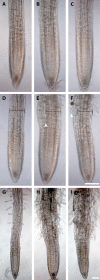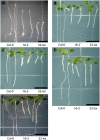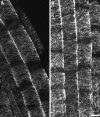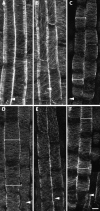Genetic evidence that cellulose synthase activity influences microtubule cortical array organization
- PMID: 18583534
- PMCID: PMC2492609
- DOI: 10.1104/pp.108.120196
Genetic evidence that cellulose synthase activity influences microtubule cortical array organization
Abstract
To identify factors that influence cytoskeletal organization we screened for Arabidopsis (Arabidopsis thaliana) mutants that show hypersensitivity to the microtubule destabilizing drug oryzalin. We cloned the genes corresponding to two of the 131 mutant lines obtained. The genes encoded mutant alleles of PROCUSTE1 and KORRIGAN, which both encode proteins that have previously been implicated in cellulose synthesis. Analysis of microtubules in the mutants revealed that both mutants have altered orientation of root cortical microtubules. Similarly, isoxaben, an inhibitor of cellulose synthesis, also altered the orientation of cortical microtubules while exogenous cellulose degradation did not. Thus, our results substantiate that proteins involved in cell wall biosynthesis influence cytoskeletal organization and indicate that this influence on cortical microtubule stability and orientation is correlated with cellulose synthesis rather than the integrity of the cell wall.
Figures








Similar articles
-
Xyloglucan Deficiency Disrupts Microtubule Stability and Cellulose Biosynthesis in Arabidopsis, Altering Cell Growth and Morphogenesis.Plant Physiol. 2016 Jan;170(1):234-49. doi: 10.1104/pp.15.01395. Epub 2015 Nov 2. Plant Physiol. 2016. PMID: 26527657 Free PMC article.
-
Mutations in the Pectin Methyltransferase QUASIMODO2 Influence Cellulose Biosynthesis and Wall Integrity in Arabidopsis.Plant Cell. 2020 Nov;32(11):3576-3597. doi: 10.1105/tpc.20.00252. Epub 2020 Sep 3. Plant Cell. 2020. PMID: 32883711 Free PMC article.
-
Mutations of cellulose synthase (CESA1) phosphorylation sites modulate anisotropic cell expansion and bidirectional mobility of cellulose synthase.Proc Natl Acad Sci U S A. 2010 Oct 5;107(40):17188-93. doi: 10.1073/pnas.1012348107. Epub 2010 Sep 20. Proc Natl Acad Sci U S A. 2010. PMID: 20855602 Free PMC article.
-
Cellulose biosynthesis in plants: from genes to rosettes.Plant Cell Physiol. 2002 Dec;43(12):1407-20. doi: 10.1093/pcp/pcf164. Plant Cell Physiol. 2002. PMID: 12514238 Review.
-
Towards the mechanism of cellulose synthesis.Trends Plant Sci. 2002 Oct;7(10):461-7. doi: 10.1016/s1360-1385(02)02335-x. Trends Plant Sci. 2002. PMID: 12399182 Review.
Cited by
-
The microtubule plus-end tracking proteins SPR1 and EB1b interact to maintain polar cell elongation and directional organ growth in Arabidopsis.Plant Cell. 2014 Nov;26(11):4409-25. doi: 10.1105/tpc.114.131482. Epub 2014 Nov 18. Plant Cell. 2014. PMID: 25415978 Free PMC article.
-
Imaging cellulose synthase motility during primary cell wall synthesis in the grass Brachypodium distachyon.Sci Rep. 2017 Nov 8;7(1):15111. doi: 10.1038/s41598-017-14988-4. Sci Rep. 2017. PMID: 29118446 Free PMC article.
-
Associations between phytohormones and cellulose biosynthesis in land plants.Ann Bot. 2020 Oct 6;126(5):807-824. doi: 10.1093/aob/mcaa121. Ann Bot. 2020. PMID: 32619216 Free PMC article. Review.
-
The Regulation of Cellulose Biosynthesis in Plants.Plant Cell. 2019 Feb;31(2):282-296. doi: 10.1105/tpc.18.00760. Epub 2019 Jan 15. Plant Cell. 2019. PMID: 30647077 Free PMC article. Review.
-
Dissecting the molecular mechanism underlying the intimate relationship between cellulose microfibrils and cortical microtubules.Front Plant Sci. 2014 Mar 13;5:90. doi: 10.3389/fpls.2014.00090. eCollection 2014. Front Plant Sci. 2014. PMID: 24659994 Free PMC article. Review.
References
-
- Arioli T, Peng L, Betzner A, Burn J, Wittke W, Herth W, Camilleri C, Höfte H, Plazinski J, Birch R, et al. (1998) Molecular analysis of cellulose biosynthesis in Arabidopsis. Science 279 717–720 - PubMed
-
- Bao Y, Kost B, Chua NH (2001) Reduced expression of α-tubulin genes in Arabidopsis thaliana specifically affects root growth and morphology, root hair development and root gravitropism. Plant J 28 145–157 - PubMed
-
- Baskin TI (2001) On the alignment of cellulose microfibrils by cortical microtubules: a review and a model. Protoplasma 215 150–171 - PubMed
-
- Baskin TI, Wilson JE, Cork A, Williamson RE (1994) Morphology and microtubule organization in Arabidopsis roots exposed to oryzalin or taxol. Plant Cell Physiol 35 935–942 - PubMed
Publication types
MeSH terms
Substances
LinkOut - more resources
Full Text Sources
Other Literature Sources
Molecular Biology Databases

